FLORENCE, ITALY
Pre-Cruise Information
Text
from Wikipedia
Florence
(Italian: Firenze) is the capital city of the Italian region
of Tuscany. It is the most
populous city in Tuscany with a population of 365,000
(700,000 in the urban area).
The city lies on the River Arno. It
is best known for its history and its importance in
the Middle Ages and in the Renaissance, especially for its
art and architecture. A centre of medieval European trade
and finance, the city is often considered the
Birthplace of the Italian
Renaissance; in fact, it has been called the Athens of
the Middle Ages.
Florence
was long under the de facto rule of the Medici family. From
1865 to 1870 the city was also the capital of the Kingdom of
Italy.
The historic centre of Florence continues to attract
millions of tourists each year and was declared a World
Heritage Site by UNESCO in 1982.
|
 |
 |
History
of Florence
Florence
was originally established by Julius Caesar in 59 BC as a
settlement for his veteran soldiers. It was named Florentia
('the flourishing') and built in the style of an army camp
with the main streets, the cardo and the decumanus,
intersecting at the present Piazza della Repubblica.
Situated at the Via Cassia, the main route between Rome and
the north, and within the fertile valley of the Arno, the
settlement quickly became an important commercial centre.
The Emperor Diocletian made Florentia the seat of a
bishopric around the beginning of the 4th century AD.
In the
ensuing two centuries, the city experienced turbulent
periods of Ostrogothic rule, during which the city was often
troubled by warfare between the Ostrogoths and the
Byzantines, which may have caused the population to fall to
as few as 1,000 living persons.
|
 |
Peace
returned under Lombard rule in the 6th century. Conquered by
Charlemagne in 774, Florence became part of the Duchy of
Tuscany, with Lucca as capital. The population began to grow
again and commerce prospered. In 854, Florence and Fiesole
were united in one county.
Margrave
Hugo chose Florence as his residency instead of Lucca at
about 1000 AD. This initiated the Golden Age of Florentine
art. In 1013, construction began on the Basilica di San
Miniato al Monte. The exterior of the baptistry was reworked
in Romanesque style between 1059 and 1128.
This period
also saw the eclipse of Florence's formerly powerful rival
Pisa (defeated by Genoa in 1284 and subjugated by Florence
in 1406), and the exercise of power by the mercantile elite
following an anti-aristocratic movement, led by Giano della
Bella, that resulted in a set of laws called the Ordinances
of Justice (1293).
|
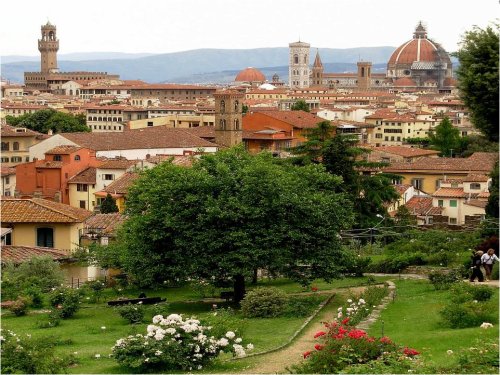 |
Of a
population estimated at 80,000 before the Black Death of
1348, about 25,000 are said to have been supported by the
city's wool industry: in 1345 Florence was the scene of an
attempted strike by wool combers (ciompi), who in 1378 rose
up in a brief revolt against oligarchic rule in the Revolt
of the Ciompi. After their suppression, Florence came under
the sway (1382-1434) of the Albizzi family, bitter rivals of
the Medici.
Cosimo de' Medici was the first Medici family
member to essentially control the city from behind the
scenes. Although the city was technically a democracy of
sorts, his power came from a vast patronage network along
with his alliance to the new immigrants, the gente nuova.
The fact that the Medici were bankers to the pope also
contributed to their rise. Cosimo was succeeded by his son
Piero, who was shortly thereafter succeeded by Cosimo's
grandson, Lorenzo in 1469. Lorenzo was a great patron of the
arts, commissioning works by Michelangelo, Leonardo da Vinci
and Botticelli. Lorenzo was also an accomplished musician
and brought some of the most famous composers and singers of
the day to Florence, including Alexander Agricola, Johannes
Ghiselin, and Heinrich Isaac. By contemporary Florentines
(and since), he was known as "Lorenzo the Magnificent"
(Lorenzo il Magnifico).
|
 |
Following
the death of Lorenzo in 1492, he was succeeded by his son
Piero II. When the French king Charles VIII invaded northern
Italy, Piero II chose to resist his army. But when he
realized the size of the French army at the gates of Pisa,
he had to accept the humiliating conditions of the French
king. These made the Florentines rebel and they expelled
Piero II. With his exile in 1494, the first period of Medici
rule ended with the restoration of a republican government.
During this period, the Dominican monk Girolamo Savonarola
had become prior of the San Marco monastery in 1490. He was
famed for his penitential sermons, lambasting what he viewed
as widespread immorality and attachment to material riches.
He blamed the exile of the Medicis as the work of God,
punishing them for their decadence. He seized the
opportunity to carry through political reforms leading to a
more democratic rule. But when Savonarola publicly accused
Pope Alexander VI of corruption, he was banned from speaking
in public. When he broke this ban, he was excommunicated.
The Florentines, tired of his extreme teachings, turned
against him and arrested him. He was convicted as a heretic
and burned at the stake on the Piazza della Signoria on 23
May 1498.
|
 |
A second
individual of unusual insight was Niccolò Machiavelli, whose
prescriptions for Florence's regeneration under strong
leadership have often been seen as a legitimization of
political expediency and even malpractice. Commissioned by
the Medici, Machiavelli also wrote the Florentine Histories,
the history of the city. Florentines drove out the Medici
for a second time and re-established a republic on May 16,
1527. Restored twice with the support of both Emperor and
Pope, the Medici in 1537 became hereditary dukes of
Florence, and in 1569 Grand Dukes of Tuscany, ruling for two
centuries. In all Tuscany, only the Republic of Lucca (later
a Duchy) and the Principality of Piombino were independent
from Florence.
The extinction of the Medici dynasty and the accession in
1737 of Francis Stephen, duke of Lorraine and husband of
Maria Theresa of Austria, led to Tuscany's temporary
inclusion in the territories of the Austrian crown. It
became a secundogeniture of the Habsburg-Lorraine dynasty,
who were deposed for the Bourbon-Parma in 1801 (themselves
deposed in 1807), restored at the Congress of Vienna;
Tuscany became a province of the United Kingdom of Italy in
1861.
|
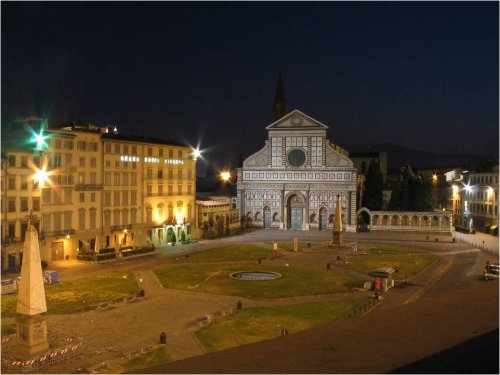 |
Florence
replaced Turin as Italy's capital in 1865.
In an effort to modernize the city, the old market in
the Piazza del Mercato Vecchio and many medieval houses were
pulled down and replaced by a more formal street plan with
newer houses. The Piazza (first renamed Piazza Vittorio
Emmanuele II, then Piazza della Repubblica,
the present name) was significantly widened and a large
triumphal arc was constructed at the west end. This
development is largely regarded as a disaster and was only
prevented from continuing by the efforts of several British
and American people living in the city. A museum recording
the destruction stands nearby today.
No one could deny the
Piazza area had
decayed from its original medieval splendor. After doubling
during the 19th century, Florence's population tripled in
the 20th with the growth of tourism, trade, financial
services and industry.
The
country's first capital city was superseded by Rome six
years later, after the withdrawal of the French troops made
its addition to the kingdom possible.
|
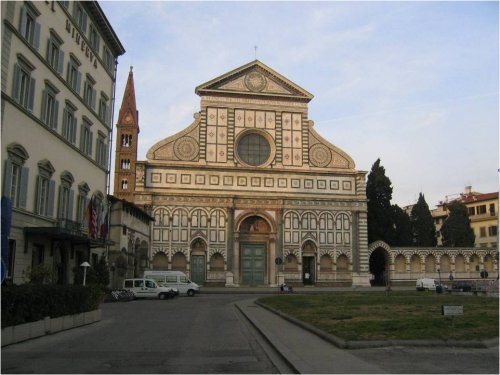 |
During
World War II the city experienced a year-long German
occupation (1943-1944) and was declared an open city. The
Allied soldiers who died driving the Germans from Tuscany
are buried in cemeteries outside the city. In 1944, the
retreating Germans decided to blow up the bridges along the
Arno linking the district of Oltrarno to the rest of the
city, thus making it difficult for the British troops to
cross. However, at the last moment Hitler ordered that the
Ponte Vecchio must not be blown up, as it was too beautiful.
Instead an equally historic area of streets directly to the
south of the bridge, including part of the Corridoio
Vasariano, was destroyed using mines.
Since then the bridges
have been restored exactly to their original forms using as
many of the remaining materials as possible, but the
buildings surrounding the Ponte Vecchio have been rebuilt in
a style combining the old with modern design. Shortly before
leaving Florence, as they knew that they would soon have to
retreat the Germans murdered many freedom fighters and
political opponents publicly, in streets and squares
including Piazza Santo Spirito.
|
 |
In November
1966, the Arno flooded parts of the center, damaging many
art treasures. There was no warning from the authorities who
knew the flood was coming, except a phone call to the
jewelers on the Ponte Vecchio. Around the city there are
tiny placards on the walls noting where the flood waters
reached at their highest point.
|
 |
Geography
Florence
lies in a sort of basin among the Senese Clavey Hills,
particularly the hills of Careggi, Fiesole, Settignano,
Arcetri, Poggio Imperiale and Bellosguardo. The Arno river
and three other minor rivers flow through it.
Although usually said to have a Mediterranean climate, under
the Köppen climate classification Florence is sometimes
classified as having a Humid subtropical climate. It
has hot, humid summers with little rainfall and cool, damp
winters. Due to being surrounded by hills in a river valley,
Florence can be hot and humid from June to August. Because
of the lack of a prevailing wind, summer temperatures are
higher than along the coast. The rain which does fall in
summer is convectional. Relief rainfall dominates in the
winter, with some snow. The highest officially recorded
temperature was 42.6°C in July 1983, the lowest was -23°C on
January 10, 1985.
|
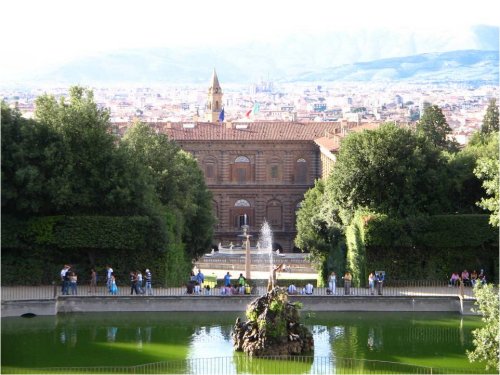 |
Main
sights
Florence is known as the “cradle of Renaissance” (la culla
del Rinascimento) for its monuments, churches and buildings.
The best-known site and crowning architectural jewel of
Florence is the domed cathedral of the city, Santa Maria del
Fiore, known as The Duomo. The magnificent dome was built by
Filippo Brunelleschi. The nearby Campanile (partly designed
by Giotto) and the Baptistery buildings are also highlights.
Both the dome itself and the campanile are open to tourists
and offer excellent views; The dome, 600 years after its
completion, is still the largest dome built in brick and
mortar in the world.
|
 |
In 1982,
the historic center of Florence was declared a World
Heritage Site by the UNESCO for the importance of its
cultural heritages. The center of the city is contained in
medieval walls that were built in the 14th century to defend
the city after it became famous and important for its
economic growth.
At the heart of the city in Piazza della Signoria is
Bartolomeo Ammanati's Fountain of Neptune (1563-1565), which
is a masterpiece of marble sculpture at the terminus of a
still functioning Roman aqueduct.
The Arno River, which cuts through the old part of the city,
is as much a character in Florentine history as many of the
people who lived there. Historically, the locals have had a
love-hate relationship with the Arno — which alternated from
nourishing the city with commerce, and destroying it by
flood.
(Rick Archer's Note: The Arno River
is also a famous Crossword Puzzle river along with
Switzerland's Aare River, Germany's Elbe River, the Oise and
Orne Rivers of France and the Yser River of Belgium)
|
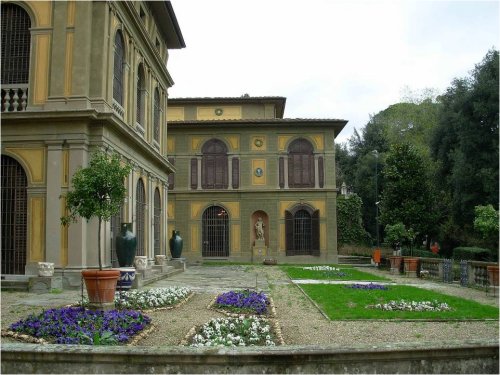 |
One of the
bridges in particular stands out as being unique — The
Ponte Vecchio (Old Bridge), whose most striking feature
is the multitude of shops built upon its edges, held up by
stilts. The Ponte Vecchio is a Medieval bridge
buit over the narrowest point of
the Arno River.The bridge also carries Vasari's elevated corridor
linking the Uffizi to the Medici residence (Palazzo Pitti).
Although the original bridge was constructed by the
Etruscans, the current bridge was rebuilt in the 14th
century It is the only bridge in the city to have survived
World War II intact.
The church of San Lorenzo contains the Medici Chapel, the
mausoleum of the Medici family - the most powerful family in
Florence from the 15th to the 18th century. Nearby is the
Uffizi Gallery, one of the finest art museums in the world -
founded on a large bequest from the last member of the
Medici family.
|

Ponte Vecchio |
The Uffizi itself is located at the corner of Piazza della
Signoria, a site important for being the centre of Florence
civil life and government for centuries (Signoria Palace is
still home of the community government): the Loggia dei
Lanzi was the set of all the public ceremonies of the
republican government. Many well known episodes of history
of art and political changes were staged here, such as:
In 1301,
Dante was sent into Exile from here (a plaque on one of the
walls of the Uffizi commemorates the event).
26 April 1478 Jacopo de'Pazzi and his retainers try to raise
the city against the Medici after the plot known as The
congiura dei Pazzi (The Pazzi conspiracy) who murdered
Giuliano di Piero de' Medici and wounded his brother
Lorenzo; the Florentines seized and hanged all the members
of the plot that could be apprehended from the windows of
the Palace.
In 1497, it was the location of the Bonfire of the Vanities
instigated by the Dominican friar and preacher Girolamo
Savonarola
On the 23 May 1498 the same Savonarola and two followers
were hanged and burnt at the stake (a round plate in the
ground commemorates the very spot were he was hanged)
|

Uffizi and
Palazzo Vecchio |
In 1504,
Michelangelo's David (now replaced by a reproduction as the
original was moved indoors to the Accademia dell'Arte del
Disegno), was installed in front of the Palazzo della
Signoria (also known as Palazzo Vecchio).
It is still the setting for a number of statues by other
sculptors such as Donatello, Giambologna, Ammannati and
Cellini, although some have been replaced with copies to
preserve the priceless originals.
In addition to the Uffizi, Florence has other world-class
museums.
The Bargello concentrates on sculpture, containing
many priceless works of art created by such sculptors as
Donatello, Giambologna, and Michelangelo. The Accademia
dell'Arte del Disegno (often simply called the Accademia)
collection's highlights are Michelangelo's David and his
unfinished Slaves.
|
 |
Across the
Arno is the huge Palazzo Pitti containing part of the Medici
family's former private collection. In addition to the
Medici collection the palace's galleries contain a large
number of Renaissance works, including several by Raphael
and Titian as well as a large collection of modern art,
costumes, cattiages, and porcelain. Adjoining the Palace are
the Boboli Gardens, elaborately landscaped and with many
interesting sculptures.
The Santa Croce basilica, originally a Franciscan
foundation, contains the monumental tombs of Galileo,
Michelangelo, Machiavelli, Dante (actually a cenotaph), and
many other notables.
Other important basilicas and churches in Florence include
Santa Maria Novella, San Lorenzo, Santo Spirito and the
Orsanmichele, and the Tempio Maggiore Great Synagogue of
Florence.
Florence has been the setting for numerous works of fiction
and movies, including the novels and associated films
Hannibal, Tea with Mussolini and A Room with a View.
|

Palazzo Pitti |
Economy
Tourism is
the most significant industry within the centre of Florence.
On any given day between April and October, the local
population is greatly outnumbered by tourists from all over
the world. The Uffizi and Accademia museums
are regularly sold out of tickets, and large groups
regularly fill the basilicas of Santa Croce and Santa Maria
Novella, both of which charge for entry.
Florence being historically the first home of Italian
fashion (the 1951-1953 soirées held by Giovanni Battista
Giorgini are generally regarded as the birth of the Italian
school as opposed to french haute couture) is also home
to the legendary Italian fashion establishment Salvatore
Ferragamo, notable as one of the oldest and most famous
Italian fashion houses. Many others, most of them now
located in Milan, were founded in Florence. Gucci, Prada,
Roberto Cavalli, and Chanel have large offices and stores in
Florence or its outskirts.
|
 |
Certain
textile industries employing largely immigrant populations
can be found to the north and north-west of the city,
continuing its long tradition as a centre of fine
fabrics.
Food and wine have long been an important staple of the
economy. Florence is the most important city in Tuscany, one
of the great wine-growing regions in the world. The Chianti
region is just south of the city, and its Sangiovese grapes
figure prominently not only in its Chianti Classico wines
but also in many of the more recently developed Supertuscan
blends. Within twenty miles (32 km) to the west is the
Carmignano area, also home to flavorful sangiovese-based
reds. The celebrated Chianti Rufina district, geographically
and historically separated from the main Chianti region, is
also few miles east of Florence. More recently, the Bolgheri
region (about 100 miles/200 kilometres southwest of
Florence) has become celebrated for its "Super Tuscan" reds
such as Sassicaia and Ornellaia.
|
 |
Florence
keeps an exceptional artistic heritage. Cimabue and Giotto,
the fathers of Italian painting, lived in Florence as well
as Arnolfo and Andrea Pisano, renewers of architecture and
sculpture; Brunelleschi, Donatello and Masaccio forefathers
of the Renaissance, Ghiberti and the Della Robbias, Filippo
Lippi and Angelico; Botticelli, Paolo Uccello and the
universal genius of Leonardo da Vinci and
Michelangelo.[11][12]
Their works, together with those of many other generations
of artists up to the artists of our century, are gathered in
the several museums of the town: the Uffizi, the most
selected gallery in the world, the Palatina gallery with the
paintings of the "Golden Ages".[13]
The Bargello Tower with the sculptures of the Renaissance,
the museum of San Marco with Angelico's works, the Academy,
the chapels of the Medicis , Buonarroti' s house with the
sculptures of Michelangelo, the following museums: Bardini,
Horne, Stibbert, Romano, Corsini, The Gallery of Modern Art,
The museum of the Opera del Duomo, the museum of Silverware
and the museum of Precious Stones.[14]
|
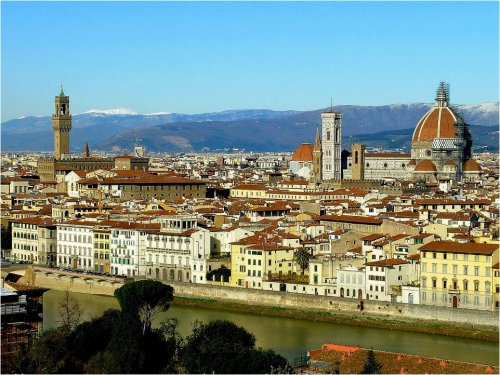 |
Great
monuments are the landmarks of Florentine artistic culture:
the Baptistry with its mosaics; the Cathedral with its
sculptures, the medieval churches with bands of frescoes;
public as well as private palaces: Palazzo Vecchio, Palazzo
Pitti, Palazzo Medici Riccardi, Palazzo Davanzati;
monasteries, cloisters, refectories; the "Certosa". In the
archeological museum includes documents of Etruscan
civilization.[15] In fact the city is so rich in art that
some first time visitors experience the Stendhal syndrome as
they encounter its art for the first time.[16]
|
 |
Transportation
The principal public transport network within the city is
run by the ATAF and Li-nea bus company, with tickets
available at local tobacconists, bars, and newspaper stalls.
Individual tickets or a pass called the Carta Agile with
multiple rides (10 or 21) may be used on buses. Once on the
bus, tickets must be stamped (or swiped for the Carta Agile)
using the machines on board unlike the train tickets which
must be validated before boarding. The main bus station is
next to Santa Maria Novella train station. Trenitalia runs
trains between the railway stations within the city, and to
other destinations around Italy and Europe. The central
station, Santa Maria Novella Station, is located about 500
metres (1,640 ft) NW of Piazza del Duomo. There is also
another important station, Campo Di Marte, but it is not as
well-known as Santa Maria Novella; most bundled routes are
Firenze-Pisa, Firenze-Viareggio and Firenze-Arezzo (along
the main line to Rome). Other local railways connect
Florence with Borgo San Lorenzo and Siena.
|
 |
Long distance
buses are run by the SITA, Copit, CAP and Lazzi companies.
The transit companies also accommodate travellers from the
Amerigo Vespucci Airport, which is five kilometers (3.1 mi)
west of the city center, and which has scheduled services
run by major European carriers such as Air France and
Lufthansa.
The centre of the city is closed to through-traffic,
although buses, taxis and residents with appropriate permits
are allowed in. This area is commonly referred to the ZTL (Zona
Traffico Limitato), which is divided into five subsections.
Residents of one section, therefore, will only be
able to drive in their district and perhaps some surrounding
ones. Cars without permits are allowed to enter after
seven-thirty at night, or before seven-thirty in the
morning. The rules shift somewhat unpredictably during the
tourist-filled summers, putting more restrictions on where
one can get in and out.
Due to the high level of air pollution and traffic in the
city, an urban tram network called the TramVia is currently
under construction in the City. It will run from Scandicci
to the southwest through the western side of the city, cross
the river Arno at the Cascine Park and arrive to the main
station of Santa Maria Novella. Two other lines are in the
final design phase.
|
 |
|
 |
 |
 |
 |
|